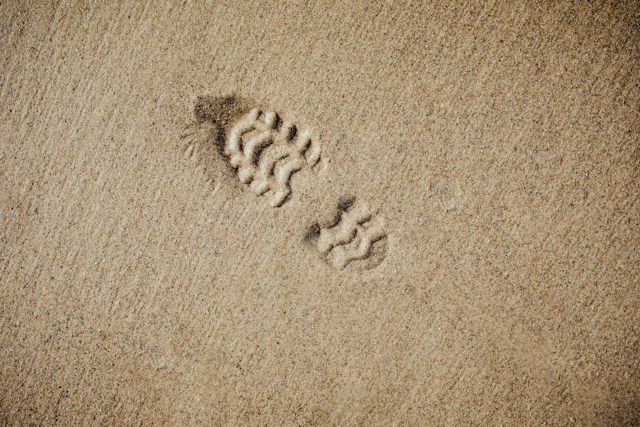Although there are many perks to the current global online environment, many concerns about it still exist. For example, many users have concerns about safety and privacy levels. There’s no keeping things to yourself, as anyone can track your online activities using your digital footprints. Unfortunately, you leave these footprints voluntarily and involuntarily as you browse the internet, even social media.
Given its nature, it is practically impossible to hide your digital footprint. However, you can reduce it to enhance your online privacy and safety. Thus, this article outlines what your online footprint entails and its consequences. You’ll also see how your digital footprints relate to your digital assets. Let’s begin by detailing the concept of a digital footprint.

What Are Digital Footprints? Understanding the Concept
If you’re hearing the phrase for the first time, you may wonder, “What are digital footprints?” A digital footprint describes the data trial or strings users leave when browsing the internet. You leave a footprint online once you perform an online action or activity. Many users also call this your electronic footprint or digital shadow.
The primary function of an electronic footprint is to track your online activities. Like a physical footprint, your digital prints can tell where you have been online. But more than that, it can also tell what you have. Thus, it is now an essential tool for establishing an online reputation, even professionally. Nevertheless, deep access to your electronic footprint by cybercriminals can compromise your safety. Therefore, minimizing your online footprint or safeguarding access to it is important.
Your digital footprint can be active or passive based on the creation mode. You create active footprints when you deliberately share information from your device. That includes accepting browser cookies, subscribing to a newsletter, or even posting on social media. Conversely, a passive footprint evolves when others collect your data without your knowledge. For example, a website collecting your IP address and cookies without permission or someone tracking your social media engagements.

What Are the Consequences of a Digital Footprint?

If someone asks you, “What are the consequences of a digital footprint?’ undoubtedly, you’d first think about security risks. While that is correct, it is not the only consequence of your digital shadow. In fact, the consequences of your digital prints could be positive or negative. Consider some positive examples.
Your digital footprint can improve your internet browsing experience. When browsers collect your cookies and cache, they’ll load faster when you visit the same websites again. Also, search engines collect your online footprint, including your habits and location. They then use this information to tailor your search results to provide more satisfactory hits when you browse the internet.
Further, social media platforms with your footprints will better suggest friends and contacts based on your history and current connections. Additionally, advertisers study your digital footprint and recommend products that’ll likely appeal to you.
Considering the negative consequences, the security risk is chief on the list. There’s a growing concern about websites and companies collecting and selling users’ online data. Cybercriminals can buy this information and perpetrate various crimes against users online. For example, anyone can steal your identity with access to your social media digital footprint. Also, they can scam and defraud you by accessing your financial footprints online.
Besides this, a negative digital footprint can create a bad reputation for you and ruin opportunities. Companies are unlikely to work with you when their background checks reveal a negative online footprint. Additionally, your peers in the industry will not want to connect with someone with a negative online footprint and reputation.

How Are Digital Assets and Digital Footprints Related?
All internet users leave electronic footprints as they use the internet, most of which have digital assets. But how are digital assets and digital footprints related? A complementary relationship exists between them, and this section provides the details. You’ve already learned what a digital footprint is, so let’s first understand what digital assets are before exploring their relationship.
A digital asset describes an individual’s property, data, or information stored electronically. That could be your document, picture, social media account, website, financial assets, intellectual property, or even your online presence. Once a property is valuable to you and you can duplicate and share it, it is a digital asset. Companies can also have digital assets.
From this definition, it is obvious that you can only create electronic footprints with digital assets. And that is the relationship between digital assets and footprints. Digital assets facilitate the creation of electronic footprints. Remember that a digital footprint is a trail of your online activities. Now, it’s clear that you only perform those activities with your digital assets.
For example, you leave a digital footprint when you browse a website or social media platform. However, that action requires your online presence, which is a digital asset. Similarly, you leave a footprint when you post pictures and videos on social media. And these documents are your digital assets. That explains the complementary nature of digital assets and footprints; electronic footprints depend on digital assets to create them.

Your Twitter Digital Footprint: An Important Social Media Footprint To Guard
As an Internet user, it is difficult to control your online footprint. You easily leave them passive while browsing the internet and conducting online activities. However, leaving a social media digital footprint is slightly different. Social media footprints are active footprints that you leave intentionally, so you have complete control of your trail here.
Twitter, now called X, is one of the leading social media platforms today. Millions of active tweeps engage the platform daily, leaving their footprints as they do. If you’re one of these, paying attention to your Twitter digital footprint is important.
The feelings and motivation behind your X interactions can be ephemeral but with lasting impacts and consequences. There are many examples of stolen identities and ruined careers accelerated by negative X footprints. However, this should not discourage your use and enjoyment of the platform. Rather, it should inform your wise and cautious use of it. How, though, do you leave footprints on X?
Your personal or Twitter business account is a digital asset, and your activities leave active electronic footprints. You create a digital shadow on X when you post content and pictures on your handle. Similarly, your footprints extend when you engage in posted content or join Twitter Circles, Lists, and Chats.
Given the public nature of these activities, anyone can track your X footprints and discern your online reputation. Moreover, Twitter curates your activities meticulously, making it easy to track these footprints. For example, your profile provides sufficient details about you. There, anyone will find all your live tweets and Likes and understand your online personality better.

Can You Hide Your Electronic Footprint on Twitter?
Trying to balance safety and a rich X experience, many tweeps wonder whether they can hide their X footprints. Unfortunately, you cannot completely hide your X footprint, although you can limit access to it. Nevertheless, this would require making your X account private, sacrificing many features available to public accounts.
Alternatively, you can keep your account public and seek ways to reduce your Twitter footprint. That is the option most tweets explore for the best X experience. Consequently, this section outlines some tips to help reduce your X footprint and people’s access to it.
Control Your Posts on Twitter To Reduce Your X Footprint
Your social media digital footprint expands with each tweet you post on X. As your posts increase, it’s easy to assign you a solid online reputation based on them. So, if you’re a serial tweeter, reducing your tweet volume is a good way to control your growing digital footprint.
Twitter influencers do the opposite of this, and you should not imitate them if you’re not using X for marketing. They need an extensive digital footprint to build a reputation, a brand, and an audience. So, if you’re not an influencer, limit your posts unless they’ll build you the right reputation.
You can also delete old tweets and irrelevant posts to thin your footprint on X. This way, you can control the reputation your footprint builds.
Reduce X Engagements and Delete Older Ones To Blur Your Twitter Footprint
Engagements, especially comments and replies, can lead to chain and unending conversations. However, each of these engagement significantly adds to your digital footprint. For example, Twitter curates your Likes under a tab in your profile, which anyone can access. Additionally, each link or ad click can start a trail from your account.
So, if you want to blur your social media footprint, pay attention to your engagements. The less you engage on social media platforms, the thinner your footprint. You can also delete older engagements after serving their purpose. You earn no reward for keeping engagements live. However, when you delete them, they’ll disappear from the platform, making it difficult to track your activities.
Make Your X Account Private To Limit Access to Your Online Footprint
You have a public account if anybody can see your profile and tweets and even follow you on X. Twitter assigns all users public accounts by default when they register on the platform. That makes it easy for anyone to track your X digital footprint. However, you can tweak your Twitter privacy settings to make your account private.
With a private X account, only your followers can access your X information, from your profile to your tweets. However, this privacy setting allows you to screen and choose your followers. So, only those you want can access your Twitter footprints. Therefore, this method does not reduce your footprints but hides them, making them available only to those whom you choose.
If you prefer this option, you follow these four steps to make your Twitter account private:
- Open the navigation menu by sliding your X homepage from left to right.
- Click “Settings and Support” and select “Settings and Privacy.”
- Open “Privacy and safety” and tap “Audience and tagging.”
- Finally, toggle the slider on the extreme left to turn on “Protect your posts.”

When To Clean Your Social Media Digital Footprint
This article has shown the positive and negative effects of an electronic footprint. Now, reflecting on your past social media activities, you know the kind of trail you’ve left and the corresponding consequences. So, if you’ve built a negative footprint, it’s best to retrace your steps and set new prints. That is easy on social media with the delete feature.
You create active footprints on social media with deliberate actions so you can erase them by undoing those actions. For example, when you delete a tweet, comment, or media post, that’s one footprint removed from your trail. Interestingly, you can even clear your entire trail by deleting all tweets!
You can also consider deactivating your Twitter account if you’re an X user. When you do this, it’ll delete your account and its entire content. That is a good solution if you intend to leave the platform for good. However, if you just need a clean slate to restart, it’s best to employ an app to delete all tweets. That can help you easily clear your digital footprints on the platform.
TweetEraser is an efficient delete-all-tweet app trusted by veteran tweeps. This Twitter management tool can erase your timeline untraceable with a single click. It can also import essential data into your archive for personal conservation. You can also use TweetEraser to automate tweet deletion to erase online prints before anyone can track them. So, start filtering and cleaning your Twitter timeline today!





